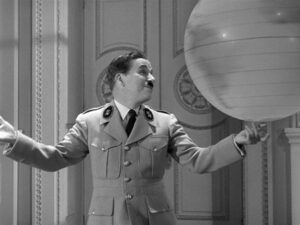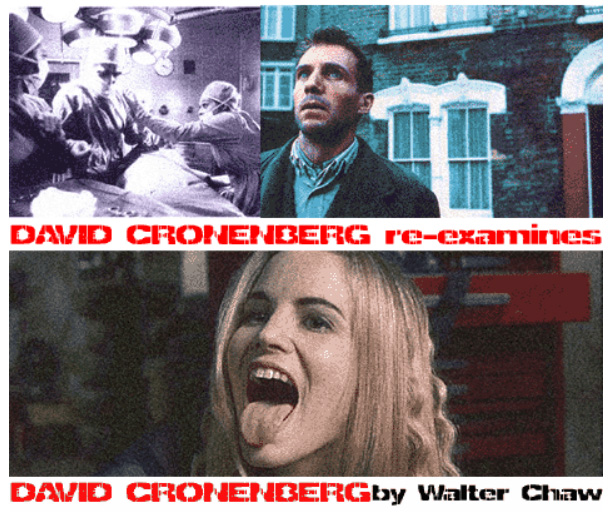***½/**** Image A- Sound A Extras B+
starring Charles Chaplin, Claire Bloom, Sydney Chaplin, Nigel Bruce
written and directed by Charles Chaplin
by Bryant Frazer The opening titles of Limelight describe the film modestly but self-consciously as “the story of a ballerina and a clown.” The clown, of course, is Chaplin himself, playing a faded superstar of the stage named Calvero. The ballerina is Chaplin’s own discovery, Claire Bloom, playing a beautiful and earnest young dancer. The story is about their relationship–how a washed-up old comedian takes a despairing young performer under his wing and gives her the confidence to become a great artist, even as his own career fades into irrelevance. The main dilemmas facing Calvero–his steadily advancing age and the fickleness of his public–were the same ones that bedevilled Chaplin at the time.
Set in London in 1914, near the end of the British music-hall era, the film begins with an inebriated (and alcoholic) Calvero discovering downstairs neighbour Thereza (Bloom) in the middle of a suicide attempt. Calvero saves the woman’s life and, because the landlady has vowed to evict her, insists that she convalesce in his apartment. Don’t get the wrong idea: by all indications, Calvero’s intentions are wholly chaste, despite that, over time, Thereza falls well and truly in love with him. They bond closely, but Calvero sees no future in their May-December relationship and guides her to a lover closer to her own age. By day, Calvero urges the dejected Thereza to embrace life and pursue her career as a dancer. At night, Calvero sleeps on a couch beneath photographs of his younger and more marketable self that occasion dreams of his past. Once her career is on the rise, Thereza does what she can to get him work, though she can do only so much for her mentor. The tide of time is always rising, never receding.
Limelight is not strictly autobiographical, of course. Most literally, it may draw on details from the life of Chaplin’s father, although Chaplin insisted it was inspired by the stage actor Frank Tierney. But the depiction of a once-beloved performer all but forgotten by his fickle public makes it hard not to see Calvero as an expression of Chaplin’s own artistic frustration. Hounded by right-wing politicians, moralists, and McCarthyites who did their best to make him persona non grata, Chaplin was already considering leaving the States for good when he made the picture. Before its release, he fled to Europe, where he remained in exile after his return privileges were revoked by the U.S. government.
Still, Limelight is hardly a political screed. Privately, Chaplin raged against an establishment he described (in a letter to Clifford Odets) as “American fascists,” but his anger manifests in Limelight as insecurity and fear of irrelevance. It finds expression in the film’s first dream sequence, which has Calvero performing an extended stage routine featuring an imaginary flea circus. At his curtain call, the applause fades, and he realizes he is performing for an empty theatre. When he is startled awake, the camera pulls back slowly from a close-up that reveals the tramp comedian’s aging face in all its creased and craggy details. Yes, you can read the sense of panic and loss in his expression, but it’s not Chaplin’s performance that makes the shot haunting. It’s his identity that does the trick; the little tramp was an ageless character, but in Limelight each of Charles Chaplin’s 60 years is plainly on display.
Yet the film is no bid for sympathy. Chaplin clearly feels there’s a righteousness to his melancholia, and Limelight is designed as an assertion of his talents. For example, it presents a showcase for his own music, including a 10-minute ballet sequence. (After Limelight finally premiered in Los Angeles twenty years later, the score won him his only competitive Oscar.) Contriving a win-win for the Chaplin clan, he cast his own son Sydney in the role of Calvero’s age-appropriate rival for the affections of Thereza. And he made sure that his own performance remained front and centre. The stage sketches Chaplin provided himself are a centrepiece, but the early shots of an inebriated Calvero dealing, barely, with the incapacitated Thereza, also demonstrate his peerless skills as a physical comic.
Well, almost peerless. Chaplin addresses that, too, by inviting the one man in the world who could possibly upstage him in his own film to share the screen with him. Chaplin’s decision to hire Buster Keaton to perform in the climactic comedy routine is often portrayed as an act of charity, since Keaton’s movie career had been in a tailspin since the 1930s. (Keaton disputed this characterization, describing himself in his autobiography as “prosperous” at the time, owing to his frequent appearances on American television.) But Keaton’s appearance was good for Chaplin, too, especially from a publicity standpoint. If it was perceived as a conspicuous display of generosity on Chaplin’s part, well, so much the better for Chaplin. Their scene together is alas just so-so–a musical number with Keaton playing a wild-haired pianist in John Lennon glasses who struggles with an unbound stack of sheet music as Chaplin, a violinist, works a bit of business where one of his legs seems to grow shorter and longer, to his apparent dismay. It’s fine and funny, but it never takes flight, and you’d like to think these two could have knocked it into orbit.
Most disappointingly, it feels like Chaplin and Keaton are rarely together in the same shot during their routine, which could suggest that Chaplin wasn’t interested in real collaboration with his co-star. (Though persistent rumour had it that Chaplin excised Keaton’s best material from the final cut, it’s hard to believe that Chaplin would hire Keaton only to deliberately sabotage him.) I should specify that I have not seen Limelight with a crowd; Chaplin didn’t bother to include laughter and applause underneath the on-screen shenanigans because he believed theatrical audiences would be howling throughout. In that regard, the experience is inevitably diminished by home viewing. At any rate, Keaton does get what’s possibly the best line in the whole film: “If anybody else says ‘It’s like old times,’ I’ll jump out the window.”
That streak of impatience, that small rebellion against sentimentality, is what saves Limelight from its worst impulses. The film is all about the passage of time, and how even the greatest of men is diminished in the end, yet it’s more than a nostalgia piece. Limelight is sad and, of course, it is self-indulgent, but it’s neither an angry picture nor a bitter one. And while it’s a comfortable and uncritical statement for Chaplin to make about the nature of his own artistry, it remains remarkably free of the self-aggrandizement you might expect. The connections it draws between the carefully-timed routines of the comic and the exquisitely-executed turns of the ballerina are on point, especially coming from the man once denounced by W.C. Fields as “nothing but a goddamned ballet dancer.” There’s some artistic truth, too, in the way that Chaplin is at his most Chaplinesque here only when Calvero has been drinking, showing how, for an artist struggling to create, alcohol can be simultaneously poison and ambrosia.
Moreover, the film is gorgeous. Cinematographer Karl Struss (Sunrise, Island of Lost Souls) gives some scenes a silvery brilliance befitting the movie’s title while imbuing others with a darker hint of expressionism that suggests the unease and dread dogging an old soul dwelling under ever-darker shadows. (For his own part, Struss observed later that Chaplin had “mellowed” in the years since they first worked together on The Great Dictator.) I love the scenes set in the dark backstage area where Thereza rehearses, with gigantic theatrical flats and long shadows carving up the space on screen like something out of a film noir or a crypt in a horror film, telegraphing the way that Thereza’s inevitable success will go hand-in-hand with Calvero’s eventual demise.
Despite the fact that it was not his actual swan song, Limelight has endured as Chaplin’s well-remembered farewell–one of the finer valedictories in all of cinema. The man may have had an enormous ego, but he knew well enough that his time was past, and Limelight is all about recognizing, nurturing, and honouring the next generation. Although deliberately precious about the gentle and loving nature of the artist, Limelight is about as gracious an acknowledgement of one’s own impending irrelevance as you can imagine.
THE BLU-RAY DISCOf all the directors represented in the Criterion Collection, Chaplin (whose catalogue was acquired by its sister distribution company, Janus Films, in 2010) gets consistently royal treatment, rivalling even that afforded to Ingmar Bergman, who may as well be the corporate mascot. The release of Limelight is no exception. Because Janus planned theatrical reissues of the Chaplin films, a 4K digital restoration was a no-brainer, and Limelight‘s original camera negative was scanned at that resolution by the famed Italian restoration lab L’Immagine Ritrovata. With the usual digital tools having been used to clean and stabilize picture and audio, the results are impressive. The film’s monochromatic palette is carefully reproduced in a 1.37:1, 1080p transfer, from the subtle gradations of grey in the carefully lit scenes inside Calvero’s apartment to the more dramatic theatrical stage lighting and a few higher-contrast shots backstage. Black levels are excellent and free of crushing while shadow detail is plentiful. (If anything, detail is too plentiful: some of Chaplin’s background projections are painfully obvious here.) Film grain is mostly soft and velvety, especially in the delicious close-up shots, which is where it counts the most, though it varies in density and cleanness of appearance. It turns into a thicker soup in the occasional process shot, and I noticed a moment or two where the grain appeared to be fighting for attention against the details in Calvero’s wallpaper, with both coming out the worse for wear. Stepping through those shots reveals a general blockiness in the backgrounds that isn’t surprising, given that the disc’s relatively stingy average bitrate of 25.7 Mbps meant the compressionists (at Radius 60 in Los Angeles) likely had to choose their battles.
The sound quality of the centre-channel LPCM track is exceptional for the era. No distortion that I could hear, no evidence of overly aggressive clean-up, and just a bit of background hiss still audible in the music tracks recorded for the ballet sequence. A full complement of special features pushes this Blu-ray close to capacity. First up is the MK2 “Chaplin Today” segment on Limelight, running 27 minutes. It offers a lot of basic context for the film that is duplicated elsewhere in the package, making it an efficient first stop for viewers. Chaplin’s son Sydney offers some biographical details about his family’s experience of London pre-World War I, and Claire Bloom shows up to talk about her memories of meeting Chaplin, the way he incorporated his mother and his wife Oona into the character of Thereza, and his persecution by the American Right. But Bernardo Bertolucci arrives with the most incisive commentary (indeed, on the entire disc), describing Limelight as a “great and sublime exorcism.” He’s spot-on as well when considering the function of Thereza’s professed love for Calvero: “The greater her love, the greater the humiliation I imagine Calvero must feel. Because he knows she’d be marrying him not out of love but out of pity. So his smiles bring you to tears.”
In a similar vein but covering mostly different material is “Chaplin’s Limelight: Its Evolution and Intimacy”, an informative 21-minute video essay in which Chaplin biographer David Robinson discusses the picture’s evolution following the release of Modern Times, the influence of the Russian dancer Vaslav Najinsky on Chaplin, and the way Limelight combines Chaplin’s fondness for ballet with his nostalgia for pre-WWI musical theatre in Leicester Square. Robinson also discusses a well-known outtake featuring the character of Claudius, an armless man he traces back to Carl Herman Unthan (a violinist and actor on the London scene in Limelight‘s time period), and digs up some stills from a flashback sequence of young Thereza that was–wisely, one suspects–cut from all versions of the film. The four-minute Claudius scene can be found elsewhere on this disc, in an interlaced dupe that dates back to an earlier DVD release, but Thereza’s flashbacks seem to no longer exist.
Criterion has included new HD interviews with Claire Bloom (16 mins.) and Norman Lloyd (15 mins.). Bloom’s segment is fine as far as it goes, making it abundantly clear that she holds Chaplin in high esteem and feels she owes her entire film career to him. It’s Lloyd who steals the show, however, with an interview conducted in 2012, the year the actor turned 98. The old codger is not simply coherent and well-spoken; he is not simply insightful about Chaplin’s working methods and artistic temperament. No, he gives a performance here, using poetic phrasing, hand gestures, and eye movement to imbue his remembrances of Chaplin, Renoir, Welles, and Hitchcock with wistfulness and warmth and delight and, most of all, drama. (Unfortunately, nobody seems to have asked him whether an anecdote attributed to him about Buster Keaton stepping in to direct Limelight‘s climactic scene is true.)
Additionally on board is the excellent 1915 short A Night in the Show, encoded in 1080p and stretch-printed to preserve a frame-rate of 18fps (this drives some silent-film buffs crazy, as the duplicated frames introduce a noticeable stutter effect on playback, but my eyes prefer it to interlacing artifacts or, ugh, speeding up the film to grotesque velocity). The piece is set in a music hall where Chaplin plays the dual roles of the lower-class tramp Mr. Rowdy and the rich drunkard Mr. Pest. Chaplin had only been in the movie business for about two years when he made it, but it’s hilarious, thanks largely to his portrayal of a terrible asshole. While the new restoration isn’t perfect, the image is damned impressive for a 100-year-old silent. Less essential is the six-minute excerpt from Chaplin’s unfinished short The Professor, where the “flea circus” routine showcased in Limelight originated. The BD platter is padded out with curios: about two minutes’ worth of Chaplin’s novel-length treatment for Limelight, titled Footlights, read by Chaplin himself, plus two theatrical trailers–one in English and one in Italian.
The 44-page booklet is anchored by “Hollywood Chaplin,” a report filed by United Press journalist Henry Gris, who got some good anecdotes from the set of Limelight, and “Portrait of an Artist as an Old Man,” a critical appreciation of Limelight‘s tear-jerking qualities by the late Peter von Bagh, artistic director of the Cineteca di Bologna‘s Il Cinema Ritrovato festival and co-founder and director of Finland’s Midnight Sun Festival. He makes a good case for the picture’s greatness as a meditation on love, memory, and death.
137 minutes; G; 1.37:1 (1080p/MPEG-4); English LPCM 1.0; BD-50; Region A; Criterion

![Limelight [Blu-ray]](https://m.media-amazon.com/images/I/51ig0MH51bL._SL500_.jpg)




